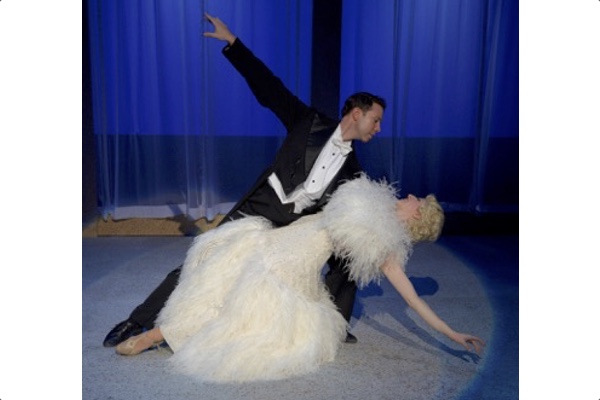Ginger Rogers Misses A Few Steps and Turns

Let’s play word association. If someone said to you Fred Astaire…? You would immediately say Ginger Rogers.
The sensational and inseparable dance partners frolicked from New York to Rio in ten gorgeous black and white musicals such as Top Hat, Shall We Dance, Swing Time and Follow the Fleet from 1933 to 1939. The world fell in love with the dancing partners as they whirled their way across a hundred stages and tap danced into film history. What other dance team could compete with them?
Backwards in High Heels: The Ginger Musical, at the Westchester Broadway Theater, in Elmsford, N.Y., conceived and developed by Lynnette Barkley and Christopher McGovern, is the Ginger Rogers story. The new musical follows dancer Ginger (born Virginia McMath) from the age of 15, when a she arrives on the Orpheum vaudeville circuit with her mother, previously a Hollywood screenwriter. The duo moves to Los Angeles and Ginger starts to land parts in films while still a teenager. She is a superstar by 25, Astaire’s dance partner and show biz box office wonder. She gets out of musicals in 1940 and stars in the movie Kitty Foyle, for which she wins an Oscar as Best Actress.
The musical tries to zero in on Ginger’s life from about 1930 to 1940, showing how her success was due to an unbelievable work ethic, a lot of pushing from her mom and, well, good luck. She had a lot of talent, and knew how to use it, but she successfully jumped from studio to studio, director to director, partner to partner and, along the way picked up five – count ‘em, five – husbands.
This should make for a lot of sizzling personal and professional drama, loaded with grudges and feuds, capped with fame with Astaire and the Oscar, right?
Somewhere along the way, the Ginger Rogers musical misses a few steps. First, and foremost, there is very little original music (McGovern) in it. The show is overladen with hit songs by Jerome Kern, George Gershwin and others, tunes such as Fascinating Rhythm, I Got Rhythm, Embraceable You, We’re in the Money, Let’s Face the Music and Dance. These are show biz standards, but they have little to do with Ginger Rogers. The show needs more original tunes.
It also needs a more intricate plot. The entire first act is just another old girl goes to Hollywood and makes good story, this one starring Ginger. The story ends in 1940, but Rogers lived until 1995. Huh? What happened in those 55 years? She was married five times and that’s cause for a lot of domestic turmoil but, in the play, there is little. Finally, worst of all, Fred Astaire is hardly in the story. They dance one or two numbers together and that’s it. If you do a musical about Ginger Rogers, you must have Fred Astaire with her more often, far more often. Would you stage a musical about Abbott and Costello without Costello? Laurel and Hardy without Hardy?
There is also nothing in the story about the Great Depression. Astaire and Roger succeeded with audiences because they provided great escapism from the Depression. that was smothering the nation. The musical should have more about the history of the times in it.
There is much good in the musical. The actress who plays Ginger Rogers, Darien Crago, displays a wide range of talents and charm. She sings and acts well and is a gifted dancer, a real hoofer. Another fine performance is by her mother, played with real depth and emotion by Erika Amato. Other talented actors in the play include Jeremy Benton as Astaire and Matt Gibson as hubby Jack Culpepper. The choreography by Benton, who also directs the show, is sweeping. This is a feel good show and you do, indeed, feel good when you leave the theater. Although the first act is slow, the second act is much improved and there is more depth to all of the performances in it. The musical has too many missteps, though, that need to be smoothed over before Ginger can really dance the night away.
Ginger Rogers was an entertainment icon of the 1930s and 1940s, one of the great dancers and actresses in film history. After she won the Oscar, Ginger made several more fine films in the 1940s and kept performing through the 1960s. She appeared in an impressive 73 films and the American Film Institute ranked her number 14 of the top 100 American entertainment stars in history. Her life, and her life with Astaire, deserves a broader storytelling.
PRODUCTION: The show is produced by the Westchester Broadway Theater and Florida Stage. Sets: Steven Loftus, Costumes: Heidi Giarlo, Sound: Jonathan Hatton, Lighting: Andrew Gmoser. The play is directed and choreographed by Jeremy Benton. The show runs through September 20.